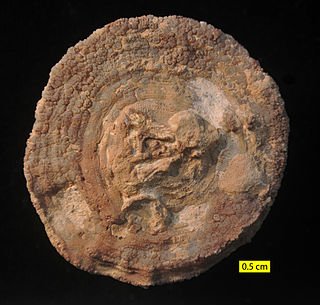
Albite is a plagioclase feldspar mineral. It is the sodium endmember of the plagioclase solid solution series. It represents a plagioclase with less than 10% anorthite content. The pure albite endmember has the formula NaAlSi
3O
8. It is a tectosilicate. Its color is usually pure white, hence its name from Latin, albus. It is a common constituent in felsic rocks.

Mindat.org is a non-commercial interactive online database covering minerals based in the United States. Originally created by Jolyon Ralph as a private project in 1993, it was launched as a community-editable website in October 2000. As of 2023 it is operated by the Hudson Institute of Mineralogy.
Dictyothyris is an extinct genus of brachiopods that lived from the Middle Jurassic to the Early Cretaceous throughout what is now Europe and North Africa.

Brachiopods, phylum Brachiopoda, are a phylum of trochozoan animals that have hard "valves" (shells) on the upper and lower surfaces, unlike the left and right arrangement in bivalve molluscs. Brachiopod valves are hinged at the rear end, while the front can be opened for feeding or closed for protection. Two major categories are traditionally recognized, articulate and inarticulate brachiopods. The word "articulate" is used to describe the tooth-and-groove structures of the valve-hinge which is present in the articulate group, and absent from the inarticulate group. This is the leading diagnostic skeletal feature, by which the two main groups can be readily distinguished as fossils. Articulate brachiopods have toothed hinges and simple, vertically-oriented opening and closing muscles. Conversely, inarticulate brachiopods have weak, untoothed hinges and a more complex system of vertical and oblique (diagonal) muscles used to keep the two valves aligned. In many brachiopods, a stalk-like pedicle projects from an opening near the hinge of one of the valves, known as the pedicle or ventral valve. The pedicle, when present, keeps the animal anchored to the seabed but clear of sediment which would obstruct the opening.
Darah District or formerly known as Darah Hazara is a District of Panjshir Province in Afghanistan. The inhabitants are predominantly Sunni Hazaras. The population in 2019 was estimated to be 15,407.

Beekite is a distinctive form of chalcedony usually associated with silica replacing carbonate minerals in fossils.

Barrington Chalk Pit is a 97.1-hectare (240-acre) geological Site of Special Scientific Interest near Barrington in Cambridgeshire. It is a Geological Conservation Review site.

Halorella is an extinct genus of brachiopods belonging to the family Halorellidae.
Juresania is an extinct genus of brachiopod that existed from the Carboniferous to the Permian.
The sulfate chlorides are double salts containing both sulfate (SO42–) and chloride (Cl–) anions. They are distinct from the chlorosulfates, which have a chlorine atom attached to the sulfur as the ClSO3− anion.

The sulfate carbonates are a compound carbonates, or mixed anion compounds that contain sulfate and carbonate ions. Sulfate carbonate minerals are in the 7.DG and 5.BF Nickel-Strunz groupings.
Chlidonophoridae is a family of brachiopods belonging to the order Terebratulida.
Chlidonophora is a genus of marine animals in the phylum Brachiopoda belonging to the family Chlidonophoridae.
Phestia is an extinct genus of clam belonging to order Nuculanida and family Nuculanidae.

Petraster is a genus of extinct Asteroid echinoderm that lived from the upper Ordovician to the late Silurian. The genus has a large distribution range, fossils have been found in North America, and Australia. Based on related echinoderms, this creature was a slow moving, benthic carnivore that possibly hunted early clams and brachiopods. It also could have had a Planktonic childhood, and also could have regenerated its arms like modern day starfish.
Phyllis Jane Fromont is a New Zealand and Australian scientist specialising in sponges.
Deslongchampsithyris is a genus of brachiopods in the family Chlidonophoridae.
Chlidonophora chuni(Blochmann, 1903) is a extant species of brachiopods in the family Chlidonophoridae.
Chlidonophora incerta is a species of brachiopod in the family Chlidonophoridae.








